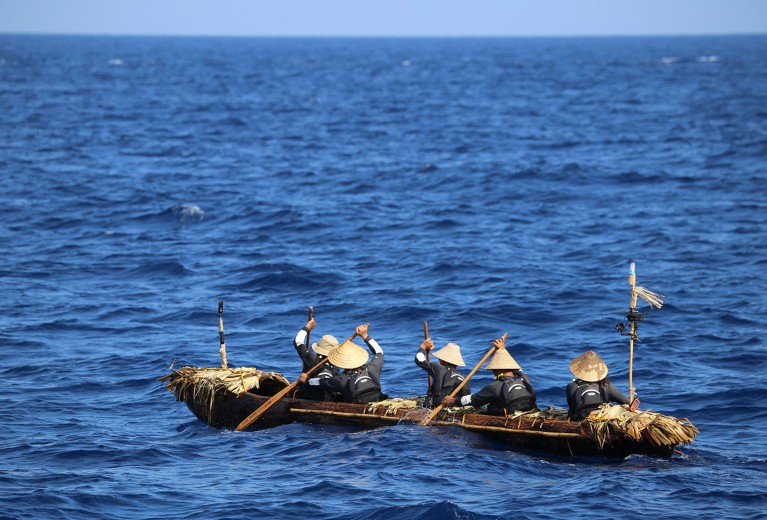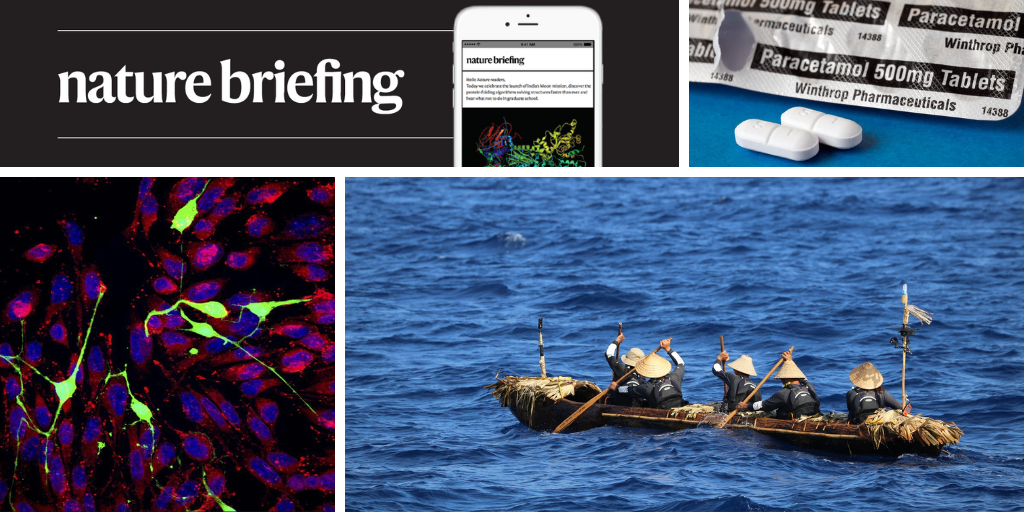You have full access to this article via your institution.
Hello Nature readers, would you like to get this Briefing in your inbox free every day? Sign up here.

Five paddlers completed a journey from Taiwan to Yonaguni Island, across some of the world’s fastest oceanic currents, without modern navigation tools.Credit: Kaifu et al./Science Advances (CC-By-ND)
Researchers have re-enacted how Stone Age people might have canoed from Taiwan to the southernmost islands of Japan to settle there more than 30,000 years ago. The team built a 7.5-metre-long canoe by hollowing out the trunk of a Japanese cedar tree with palaeolithic tools. Five paddlers then set off from Wushibi, on the east coast of Taiwan, and used the sun and stars as navigation aids. Some 45 hours and 225 kilometres later, they landed on Yonaguni Island. Evolutionary anthropologist and Stone Age role-player Yosuke Kaifu hopes that this study will highlight how an ancient Asian civilization “did a great thing with limited technology”.
Reference: Science Advances paper
An engineered strain of Escherichia coli can help to make the painkiller paracetamol — known to many as Tylenol — from plastic waste. Researchers found that if they converted polyethylene terephthalate (PET) plastic waste into an intermediary material, E. coli could use a chemical reaction never before observed in nature to turn the plastic into a molecule called PABA. With the help of two inserted genes, the bacteria could convert PABA into paracetamol. “People don’t realise that paracetamol comes from oil currently,” says biochemist and study co-author Stephen Wallace. This method could be a way to “completely hoover up plastic waste”.
Go deeper with an analysis by a group of synthetic chemists in the Nature Chemistry News & Views article. (6 min read)
Reference: Nature Chemistry paper
Cancer cells turbocharge themselves by stealing mitochondria — cellular structures that generate energy — from nerve cells. Researchers found that cancer cells can siphon off the neurons’ mitochondria through ultrathin tubes that grow between the two types of cell. This act of thievery seems to give cancer cells a boost to help them withstand the stress of shooting through blood vessels when they metastasize, or spread to distant organs. “Now we have a new culprit for metastasis, which means we have a new target to block metastasis,” says cancer neurobiologist and study co-author Simon Grelet.
When fed to mice, betaine — a modified amino acid made by the kidneys and involved in metabolism — can reproduce some of the benefits of exercise and slow some signs of ageing. Researchers found that old mice given water spiked with the molecule had stronger muscles, less inflammation and more youthful skin than their counterparts who did not get the supplement. Whether it would have the same effect in humans is unclear, but even if it did, it couldn’t replicate all of the myriad benefits of exercise, says neuroscientist Christiane Wrann.
Features & opinion
Since May, the administration of US President Donald Trump has made sweeping cuts to research grants totalling more than US$2.4 billion awarded to Harvard University. The government has also sought to ban international students from attending the storied institution. Harvard is fighting both actions in court, and legal experts predict that the university is likely to prevail, but how and when remains unclear. For now, stopgap funding measures, such as tapping into endowment funds, can keep some research afloat. But these can’t go on forever. In the face of uncertainty, Harvard leaders are now thinking about how to design a viable — and probably smaller — institution that is less reliant on federal support. Without stable funding, “there’s no way that we can conduct research at the same scale that we did before”, says pulmonologist Mary Rice, whose grants were cancelled. “This is going to have implications that could last for generations.”

Source: Harvard Univ. Financial Report Fiscal Year 2024
Circular-economy researcher Julian Kirchherr had always dreamed of being a professor, but the academic treadmill left him craving more real-world impact. As a ‘pracademic’, Kirchherr has a tenured position at a university and a job as a management consultant. “Although most of my consulting work has little to do with my academic research, I value being a pracademic,” writes Kirchherr “Above all, I appreciate the freedom to follow ideas that genuinely interest me — and I feel most alive as a scholar when writing about them.”
Image of the week

The James Webb Space Telescope (JWST) has discovered its first exoplanet, marked in this image as CC#1. The planet, named TWA 7b, is the lightest exoplanet ever detected at around a third of the mass of Jupiter. JWST picked up infrared radiation while taking a look at the star CE Antliae (the central black splodge), which astronomers deemed was coming from a young planet. (Space.com | 6 min read)
Reference: Nature paper (A.-M. Lagrange et al/Nature )
Earlier this week, Briefing readers were staring and squinting at the Coffer Illusion — a series of line segments that can be seen as either a grid of rectangles or one of circles. Since so many of you got in touch to share your love of mind-boggling imagery, today, I offer you the candidates for Best Illusion of the Year 2024.
Entries range from a hexagonal prism that appears rounded in a mirror to a cube ‘floating’ in mid air. You can vote for your favourite using a star-rating system.
Let us know your pick for winner, and any feedback you have on this newsletter, at [email protected].
Thanks for reading,
Jacob Smith, associate editor, Nature Briefing
With contributions by Flora Graham
• Nature Briefing: Careers — insights, advice and award-winning journalism to help you optimize your working life
• Nature Briefing: Microbiology — the most abundant living entities on our planet — microorganisms — and the role they play in health, the environment and food systems
• Nature Briefing: Anthropocene — climate change, biodiversity, sustainability and geoengineering
• Nature Briefing: AI & Robotics — 100% written by humans, of course
• Nature Briefing: Cancer — a weekly newsletter written with cancer researchers in mind
• Nature Briefing: Translational Research — covers biotechnology, drug discovery and pharma


